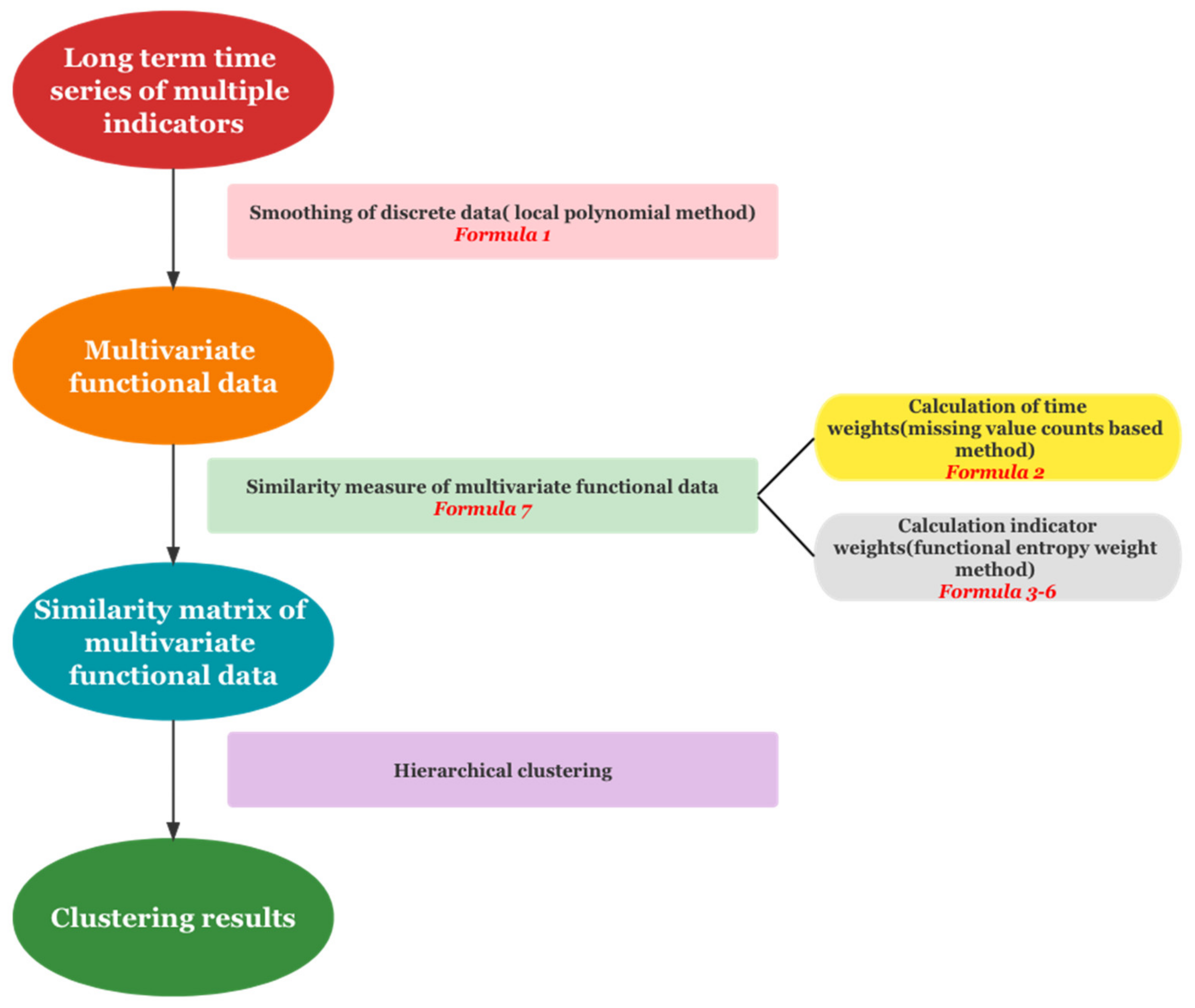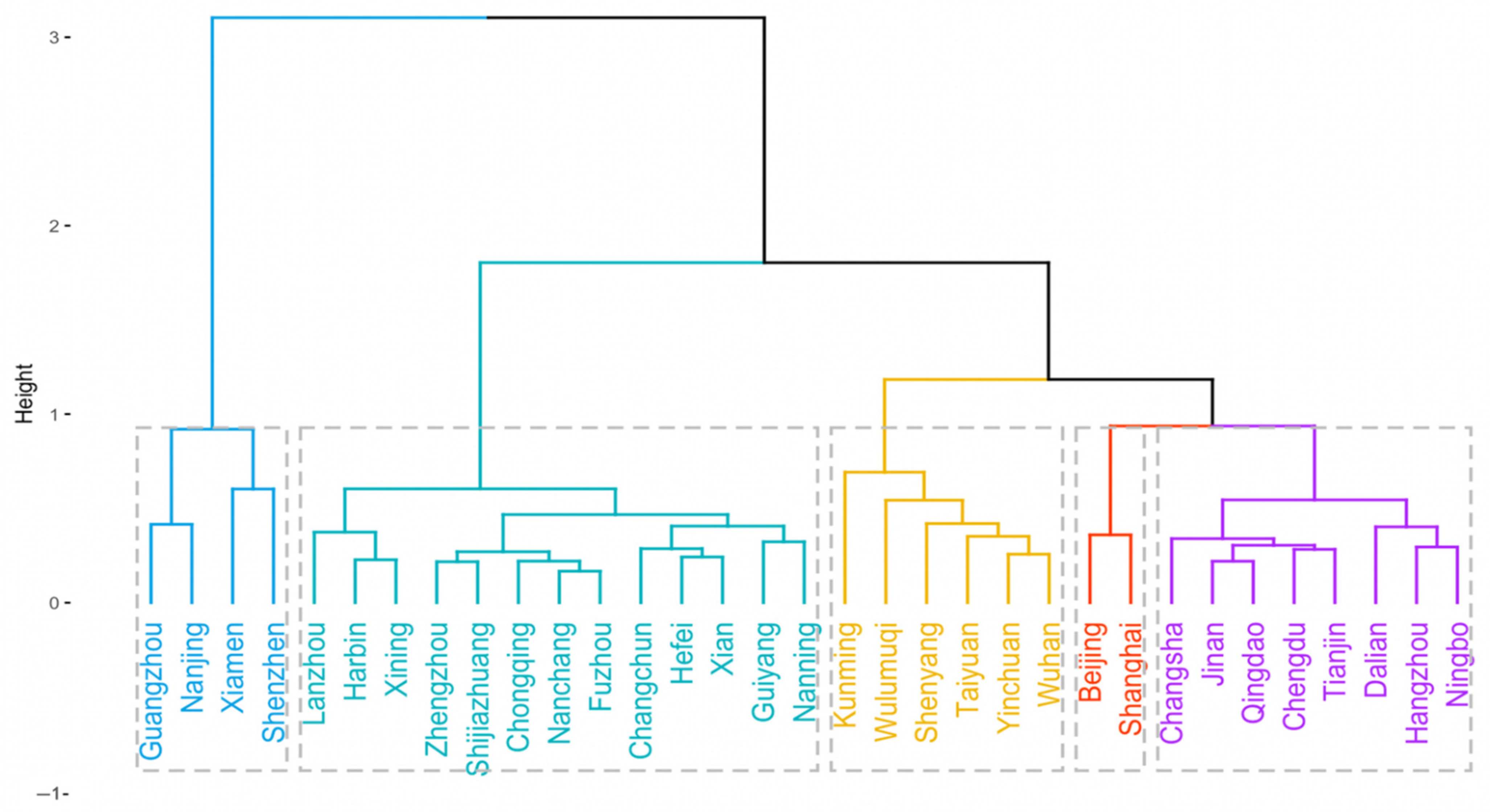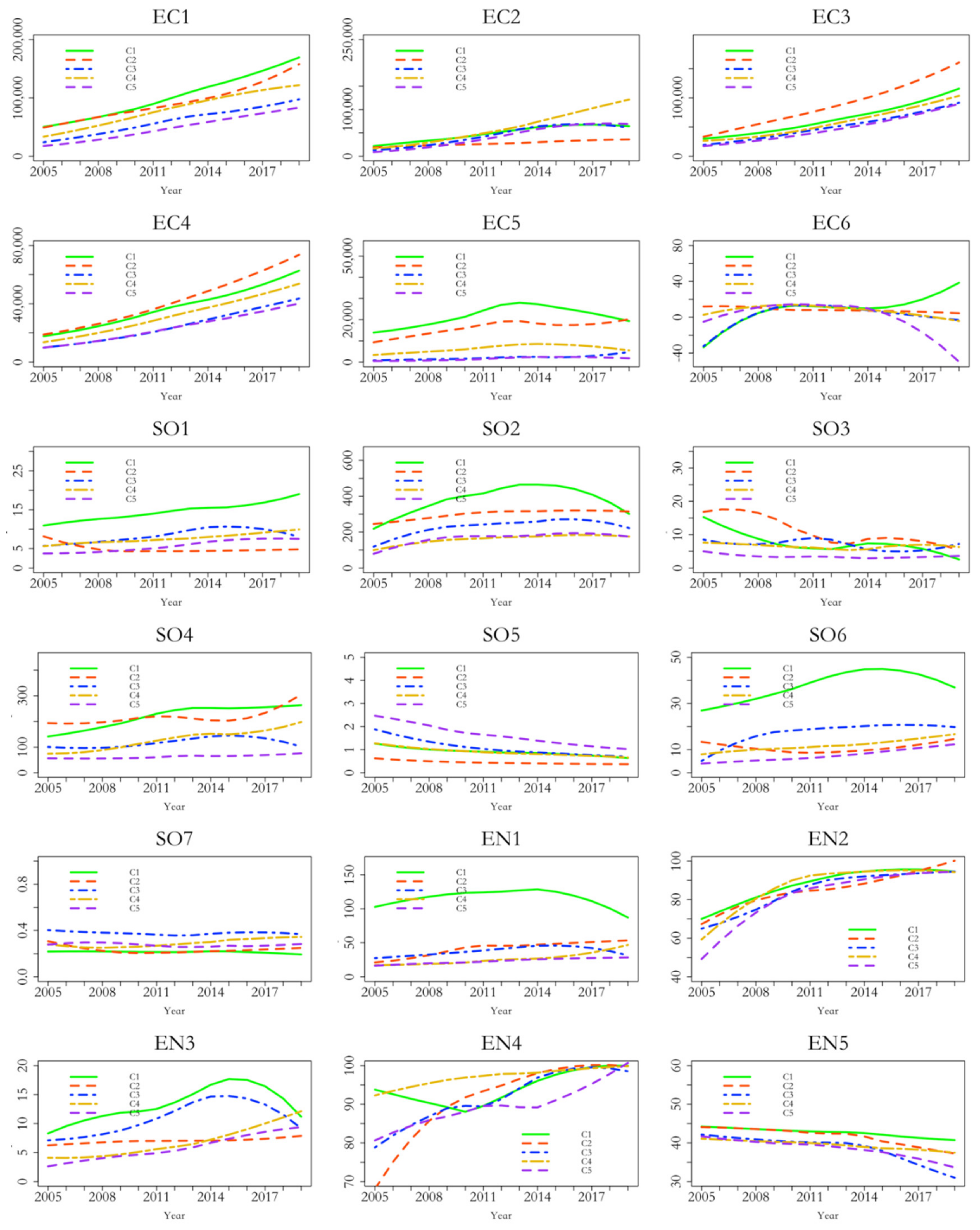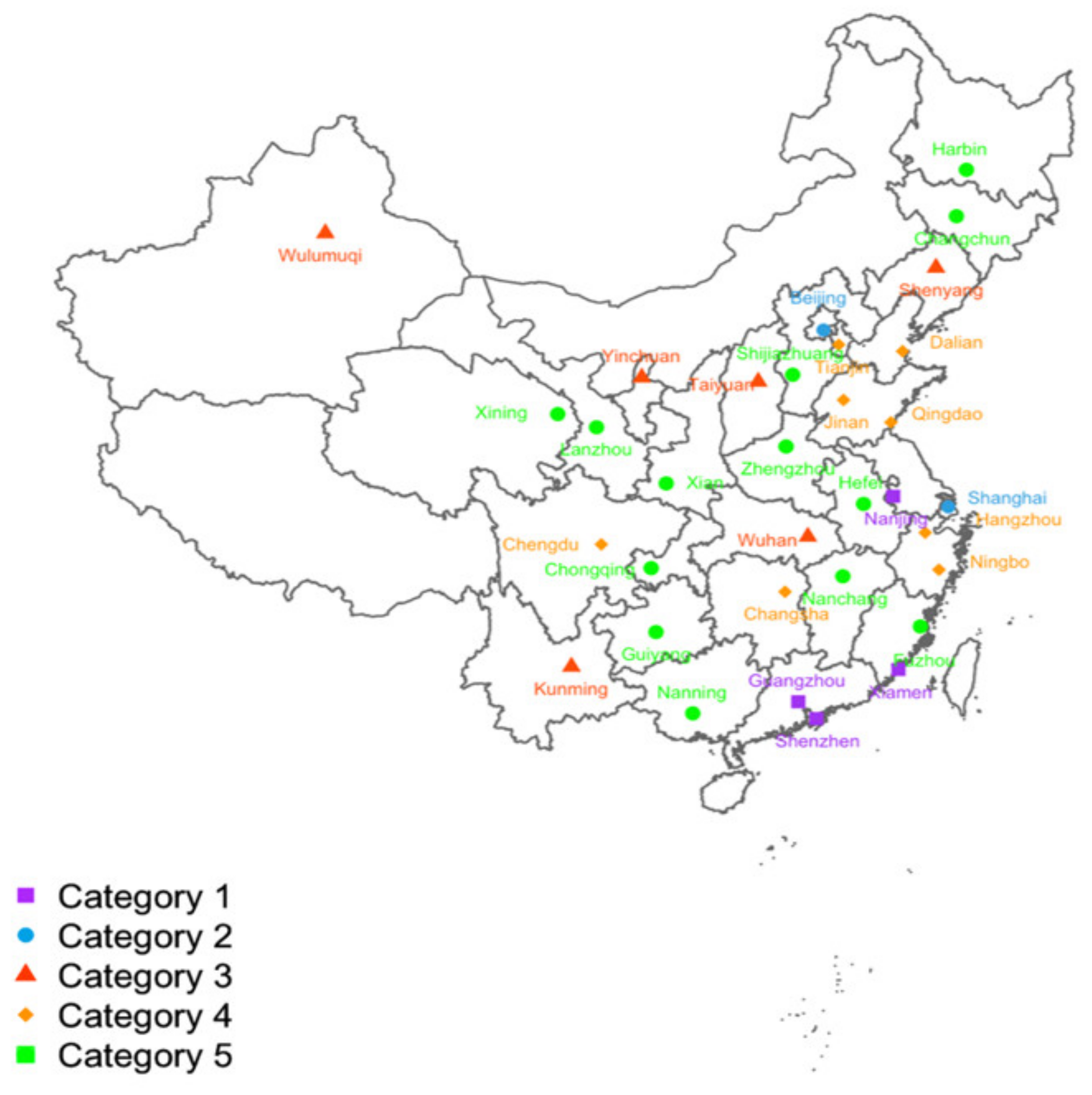Exploring the Differences of Sustainable Urban Development Levels from the Perspective of Multivariate Functional Data Analysis: A Case Study of 33 Cities in China
Abstract
1. Introduction
2. Sustainable Urban Development Evaluation Framework
3. Materials and Methods
3.1. Data
3.2. Methods
3.2.1. Discrete Data Smoothing
3.2.2. Calculation of Weights
- (1)
- Time Weights ().
- (2)
- Indicator Weights Based on the Functional Entropy Weight Method ()
3.2.3. An Distance-Based Similarity Measure and Multivariate Functional Clustering
3.2.4. Clustering Procedures for Long-term Series Data of Multiple Indicators
3.2.5. Defining Hierarchical Clustering Categories
4. Empirical Analysis
4.1. Construction of the Index System
4.2. Data Per Capita
4.3. Empirical Evaluation
4.4. Result and Discussion
5. Conclusions and Suggestions
- Balanced and sustainable development is needed in the three dimensions of economy, society, and environment. The coordinated development of the economy, society, and environment can promote the sustainable development of cities. Based on the clustering results of this paper, cities with a higher level of sustainable urban development have coordinated development in the three dimensions of economy, society, and environment and have a high balance, thus, requiring balanced development;
- According to the urban clustering results, the sustainable development levels of central and western cities in China and the cities in the east have a large gap. The sustainable development level of cities in Eastern China is relatively high, and they should continue to give full play to their advantages and maintain robust and sustainable development capabilities. The capability of sustainable development in central and western cities is relatively weak. Therefore, these cities should address their shortcomings in time and formulate relevant policies according to their characteristics and local conditions to improve their overall sustainable development capabilities;
- The city’s rapid development should not be overly dependent on the consumption of the environment and resources, and should pay attention to the sustainable development of the environment. According to the urban clustering results, except for the first type of cities, the level of environmental development of other categories of cities slightly differs. The first category of cities should maintain their advantages and prioritize the environment and green development. The other four categories of cities should focus on the protection and construction of the urban environment, improve the efficiency of improving the ecological environment, enhance the ability of environmental development, and realize the sustainable and healthy development of the city.
Supplementary Materials
Author Contributions
Funding
Institutional Review Board Statement
Informed Consent Statement
Data Availability Statement
Conflicts of Interest
Appendix A
| Year | Time Weights | Year | Time Weights | Year | Time Weights |
|---|---|---|---|---|---|
| 2005 | 0.004 | 2010 | 0.133 | 2015 | 0.061 |
| 2006 | 0.011 | 2011 | 0.161 | 2016 | 0.031 |
| 2007 | 0.026 | 2012 | 0.164 | 2017 | 0.013 |
| 2008 | 0.054 | 2013 | 0.141 | 2018 | 0.005 |
| 2009 | 0.092 | 2014 | 0.101 | 2019 | 0.001 |
| Sub-Indices | Indicators | Code | Indicator Weights |
|---|---|---|---|
| Economic indices | Per capita GDP (RMB) | EC1 | 0.145 |
| Per capita investment in fixed assets (RMB) | EC2 | 0.122 | |
| The average salary of on-the-job employees (RMB) | EC3 | 0.163 | |
| Per capita disposable income of urban households (RMB) | EC4 | 0.145 | |
| Per capita total import and export (Dollar) | EC5 | 0.388 | |
| Growth rate of GDP (%) | EC6 | 0.038 | |
| Social indices | Per capita urban road area (m2) | SO1 | 0.149 |
| Number of passengers taking public transport per capita (Pieces) | SO2 | 0.128 | |
| Sales area of villas and high-end apartments per 100 people (m2) | SO3 | 0.123 | |
| Number of books in public libraries per 100 people (Copies) | SO4 | 0.125 | |
| Number of primary schools per 10000 people (Places) | SO5 | 0.113 | |
| Number of urban parks per 10,000 people (Places) | SO6 | 0.279 | |
| Number of hospitals per 10,000 people (Places) | SO7 | 0.082 | |
| Environmental indices | Per capita urban green coverage area (m2) | EN1 | 0.525 |
| Urban sewage treatment rate (%) | EN2 | 0.070 | |
| Per capita urban cleaning area (m2) | EN3 | 0.258 | |
| Disposal rate of living garbage harmless (%) | EN4 | 0.081 | |
| Green coverage rate of built-up areas (%) | EN5 | 0.066 |
References
- Newman, P.; Jennings, I. Cities as Sustainable Ecosystems: Principles and Practices; Island Press: Washington, DC, USA, 2008; ISBN 978-1-59726-187-6. [Google Scholar]
- Wu, J.G. Urban Sustainability: An Inevitable Goal of Landscape Research. Landsc. Ecol. 2010, 25, 1–4. [Google Scholar] [CrossRef]
- Singh, R.K.; Murty, H.R.; Gupta, S.K.; Dikshit, A.K. An Overview of Sustainability Assessment Methodologies. Ecol. Indic. 2012, 15, 281–299. [Google Scholar] [CrossRef]
- United Nations. Transforming Our World: The 2030 Agenda for Sustainable Development. Available online: https://www.un.org/sustainabledevelopment/ (accessed on 7 September 2022).
- World Investment Report 2020: International Production beyond the Pandemic 2020. Available online: https://unctad.org/webflyer/world-investment-report-2020#tab-2/ (accessed on 7 September 2022).
- UN-Habitat. The Value of Sustainable Urbanization; World Cities Report; UN-Habitat: Nairobi, Kenya, 2020; ISBN 978-92-1-005438-6. [Google Scholar]
- Zhang, L.; Xu, Y.; Yeh, C.-H.; Liu, Y.; Zhou, D. City Sustainability Evaluation Using Multi-Criteria Decision Making with Objective Weights of Interdependent Criteria. J. Clean. Prod. 2016, 131, 491–499. [Google Scholar] [CrossRef]
- Ma, L.; Li, D.D.; Tao, X.B.; Dong, H.F.; He, B.; Ye, X. Inequality, Bi-Polarization and Mobility of Urban Infrastructure Investment in China’s Urban System. Sustainability 2017, 9, 1600. [Google Scholar] [CrossRef]
- Degbelo, A.; Granell, C.; Trilles, S.; Bhattacharya, D.; Casteleyn, S.; Kray, C. Opening up Smart Cities: Citizen-Centric Challenges and Opportunities from GIScience. ISPRS Int. J. Geo-Inf. 2016, 5, 16. [Google Scholar] [CrossRef]
- United Nations. Report of the World Commission on Environment and Development: Our Common Future; United Nations: New York, NY, USA, 1987. [Google Scholar]
- Tang, J.; Zhu, H.L.; Liu, Z.; Jia, F.; Zheng, X.X. Urban Sustainability Evaluation under the Modified TOPSIS Based on Grey Relational Analysis. Int. J. Environ. Res. Public. Health 2019, 16, 256. [Google Scholar] [CrossRef]
- Tanguay, G.A.; Rajaonson, J.; Lefebvre, J.-F.; Lanoie, P. Measuring the Sustainability of Cities: An Analysis of the Use of Local Indicators. Ecol. Indic. 2010, 10, 407–418. [Google Scholar] [CrossRef]
- Huang, L.; Wu, J.G.; Yan, L.J. Defining and Measuring Urban Sustainability: A Review of Indicators. Landsc. Ecol. 2015, 30, 1175–1193. [Google Scholar] [CrossRef]
- Parnell, S. Defining a Global Urban Development Agenda. World Dev. 2016, 78, 529–540. [Google Scholar] [CrossRef]
- Sun, C.; Tong, Y.; Zou, W. The Evolution and a Temporal-Spatial Difference Analysis of Green Development in China. Sustain. Cities Soc. 2018, 41, 52–61. [Google Scholar] [CrossRef]
- Wu, J.G. Urban Ecology and Sustainability: The State-of-the-Science and Future Directions. Landsc. Urban Plan. 2014, 125, 209–221. [Google Scholar] [CrossRef]
- Bibri, S.E.; Krogstie, J. Smart Sustainable Cities of the Future: An Extensive Interdisciplinary Literature Review. Sustain. Cities Soc. 2017, 31, 183–212. [Google Scholar] [CrossRef]
- Fan, Y.P.; Fang, C.L.; Zhang, Q. Coupling Coordinated Development between Social Economy and Ecological Environment in Chinese Provincial Capital Cities-Assessment and Policy Implications. J. Clean. Prod. 2019, 229, 289–298. [Google Scholar] [CrossRef]
- Cao, S.; Lv, Y.; Zheng, H.; Wang, X. Challenges Facing China’s Unbalanced Urbanization Strategy. Land Use Policy 2014, 39, 412–415. [Google Scholar] [CrossRef]
- Turcu, C. Re-Thinking Sustainability Indicators: Local Perspectives of Urban Sustainability. J. Environ. Plan. Manag. 2013, 56, 695–719. [Google Scholar] [CrossRef]
- Magee, L.; Scerri, A.; James, P.; Thom, J.A.; Padgham, L.; Hickmott, S.; Deng, H.; Cahill, F. Reframing Social Sustainability Reporting: Towards an Engaged Approach. Environ. Dev. Sustain. 2013, 15, 225–243. [Google Scholar] [CrossRef]
- Phillis, Y.A.; Kouikoglou, V.S.; Verdugo, C. Urban Sustainability Assessment and Ranking of Cities. Comput. Environ. Urban Syst. 2017, 64, 254–265. [Google Scholar] [CrossRef]
- Huang, L.; Yan, L.J.; Wu, J.G. Assessing Urban Sustainability of Chinese Megacities: 35 Years after the Economic Reform and Open-Door Policy. Landsc. Urban Plan. 2016, 145, 57–70. [Google Scholar] [CrossRef]
- Akande, A.; Cabral, P.; Gomes, P.; Casteleyn, S. The Lisbon Ranking for Smart Sustainable Cities in Europe. Sustain. Cities Soc. 2019, 44, 475–487. [Google Scholar] [CrossRef]
- Ding, L.; Shao, Z.F.; Zhang, H.C.; Xu, C.; Wu, D.W. A Comprehensive Evaluation of Urban Sustainable Development in China Based on the TOPSIS-Entropy Method. Sustainability 2016, 8, 746. [Google Scholar] [CrossRef]
- Wang, Y.Q.; Yuan, G.H.; Yan, Y.; Zhang, X. Evaluation of Sustainable Urban Development under Environmental Constraints: A Case Study of Jiangsu Province, China. Sustainability 2020, 12, 1049. [Google Scholar] [CrossRef]
- Shaker, R.R.; Zubalsky, S.L. Examining Patterns of Sustainability across Europe: A Multivariate and Spatial Assessment of 25 Composite Indices. Int. J. Sustain. Dev. World Ecol. 2014, 22, 1–13. [Google Scholar] [CrossRef]
- Bateman, I.J.; Mace, G.M.; Fezzi, C.; Atkinson, G.; Turner, K. Economic Analysis for Ecosystem Service Assessments. Environ. Resour. Econ. 2011, 48, 177–218. [Google Scholar] [CrossRef]
- Yigitcanlar, T.; Kamruzzaman, M. Does Smart City Policy Lead to Sustainability of Cities? Land Use Policy 2018, 73, 49–58. [Google Scholar] [CrossRef]
- Chen, X.; Liu, X.; Hu, D.B. Assessment of Sustainable Development: A Case Study of Wuhan as a Pilot City in China. Ecol. Indic. 2015, 50, 206–214. [Google Scholar] [CrossRef]
- Musakwa, W.; Van Niekerk, A. Monitoring Sustainable Urban Development Using Built-up Area Indicators: A Case Study of Stellenbosch, South Africa. Environ. Dev. Sustain. 2015, 17, 547–566. [Google Scholar] [CrossRef]
- Hussain, T.; Abbas, J.; Wei, Z.; Ahmad, S.; Xuehao, B.; Gaoli, Z. Impact of Urban Village Disamenity on Neighboring Residential Properties: Empirical Evidence from Nanjing through Hedonic Pricing Model Appraisal. J. Urban Plan. Dev. 2021, 147, 04020055. [Google Scholar] [CrossRef]
- Zhang, M.; Liu, Y.M.; Wu, J.; Wang, T.T. Index System of Urban Resource and Environment Carrying Capacity Based on Ecological Civilization. Environ. Impact Assess. Rev. 2018, 68, 90–97. [Google Scholar] [CrossRef]
- Yigitcanlar, T.; Han, H.; Kamruzzaman, M.; Ioppolo, G.; Sabatini-Marques, J. The Making of Smart Cities: Are Songdo, Masdar, Amsterdam, San Francisco and Brisbane the Best We Could Build? Land Use Policy 2019, 88, 104187. [Google Scholar] [CrossRef]
- Yuan, G.H.; Yang, W.X. Evaluating China’s Air Pollution Control Policy with Extended AQI Indicator System: Example of the Beijing-Tianjin-Hebei Region. Sustainability 2019, 11, 939. [Google Scholar] [CrossRef]
- Martin, C.J.; Evans, J.; Karvonen, A. Smart and Sustainable? Five Tensions in the Visions and Practices of the Smart-Sustainable City in Europe and North America. Technol. Forecast. Soc. Chang. 2018, 133, 269–278. [Google Scholar] [CrossRef]
- Meng, F.X.; Guo, J.L.; Guo, Z.Q.; Lee, J.C.K.; Liu, G.Y.; Wang, N. Urban Ecological Transition: The Practice of Ecological Civilization Construction in China. Sci. Total Environ. 2021, 755, 142633. [Google Scholar] [CrossRef]
- Zhao, J.J.; Chai, L. A Novel Approach for Urbanization Level Evaluation Based on Information Entropy Principle: A Case of Beijing. Phys. Stat. Mech. Its Appl. 2015, 430, 114–125. [Google Scholar] [CrossRef]
- Shen, L.; Zhou, J.Y.; Skitmore, M.; Xia, B. Application of a Hybrid Entropy–McKinsey Matrix Method in Evaluating Sustainable Urbanization: A China Case Study. Cities 2015, 42, 186–194. [Google Scholar] [CrossRef]
- Wei, Y.G.; Huang, C.; Lam, P.; Sha, Y.; Feng, Y. Using Urban-Carrying Capacity as a Benchmark for Sustainable Urban Development: An Empirical Study of Beijing. Sustainability 2015, 7, 3244–3268. [Google Scholar] [CrossRef]
- Lin, W.X.; Hong, C.Q.; Zhou, Y.K. Multi-Scale Evaluation of Suzhou City’s Sustainable Development Level Based on the Sustainable Development Goals Framework. Sustainability 2020, 12, 976. [Google Scholar] [CrossRef]
- Zhang, H.Y.; Uwasu, M.; Hara, K.; Yabar, H. Sustainable Urban Development and Land Use Change A Case Study of the Yangtze River Delta in China. Sustainability 2011, 2, 1074–1089. [Google Scholar] [CrossRef]
- Lane, M. The Carrying Capacity Imperative: Assessing Regional Carrying Capacity Methodologies for Sustainable Land-Use Planning. Land Use Policy 2010, 27, 1038–1045. [Google Scholar] [CrossRef]
- Ding, X.H.; Zhong, W.Z.; Shearmur, R.G.; Zhang, X.L.; Huisingh, D. An Inclusive Model for Assessing the Sustainability of Cities in Developing Countries—Trinity of Cities’ Sustainability from Spatial, Logical and Time Dimensions (TCS-SLTD). J. Clean. Prod. 2015, 109, 62–75. [Google Scholar] [CrossRef]
- Ramsay, J.O. When the Data Are Functions. Psychometrika 1982, 47, 379–396. [Google Scholar] [CrossRef]
- Wang, J.-L.; Chiou, J.-M.; Müller, H.-G. Functional Data Analysis. Annu. Rev. Stat. Its Appl. 2016, 3, 257–295. [Google Scholar] [CrossRef]
- Reiss, P.T.; Goldsmith, J.; Shang, H.L.; Ogden, R.T. Methods for Scalar-on-Function Regression: Scalar-on-Function Regression. Int. Stat. Rev. 2017, 85, 228–249. [Google Scholar] [CrossRef]
- Happ, C.; Greven, S. Multivariate Functional Principal Component Analysis for Data Observed on Different (Dimensional) Domains. J. Am. Stat. Assoc. 2018, 113, 649–659. [Google Scholar] [CrossRef]
- Jacques, J.; Preda, C. Model-Based Clustering for Multivariate Functional Data. Comput. Stat. Data Anal. 2014, 71, 92–106. [Google Scholar] [CrossRef]
- International Council for Science. Sustainability Indicators: A Scientific Assessment; Hák, T., Moldan, B., Dahl, A.L., Eds.; SCOPE Series; Island Press: Washington, DC, USA, 2007; ISBN 978-1-59726-130-2. [Google Scholar]
- Xie, Y.; Liu, C.; Chang, S.; Jiang, B. Urban Sustainability: Integrating Socioeconomic and Environmental Data for Multi-Objective Assessment. Sustainability 2022, 14, 9142. [Google Scholar] [CrossRef]
- Li, F.; Liu, X.S.; Hu, D.; Wang, R.; Yang, W.; Li, D.; Zhao, D. Measurement Indicators and an Evaluation Approach for Assessing Urban Sustainable Development: A Case Study for China’s Jining City. Landsc. Urban Plan. 2009, 90, 134–142. [Google Scholar] [CrossRef]
- Michalina, D.; Mederly, P.; Diefenbacher, H.; Held, B. Sustainable Urban Development: A Review of Urban Sustainability Indicator Frameworks. Sustainability 2021, 13, 9348. [Google Scholar] [CrossRef]
- Li, Y.; Zhang, X.; Gao, X. An Evaluation of the Coupling Coordination Degree of an Urban Economy–Society–Environment System Based on a Multi-Scenario Analysis: The Case of Chengde City in China. Sustainability 2022, 14, 6790. [Google Scholar] [CrossRef]
- Yang, Y.H.; Hu, A.A. Investigating Regional Disparities of China’s Human Development with Cluster Analysis: A Historical Perspective. Soc. Indic. Res. 2008, 86, 417–432. [Google Scholar] [CrossRef]
- Analyse des Yale Environmental Performance Index. Available online: https://www.umweltbundesamt.de/ (accessed on 7 September 2022).
- Siche, J.R.; Agostinho, F.; Ortega, E.; Romeiro, A. Sustainability of Nations by Indices: Comparative Study between Environmental Sustainability Index, Ecological Footprint and the Emergy Performance Indices. Ecol. Econ. 2008, 66, 628–637. [Google Scholar] [CrossRef]
- Rogge, N. Undesirable Specialization in the Construction of Composite Policy Indicators: The Environmental Performance Index. Ecol. Indic. 2012, 23, 143–154. [Google Scholar] [CrossRef]
- National Bureau of Statistics. China City Statistical Yearbook, 2005–2019; China Statistics Press: Beijing, China, 2020. [Google Scholar]
- Zhang, J.T. Analysis of Variance for Functional Data; CRC Press: Boca Raton, FL, USA, 2013. [Google Scholar]
- Shannon, C.E.; Weaver, W.; Wiener, N. The Mathematical Theory of Communication. Phys. Today 1950, 3, 31–32. [Google Scholar] [CrossRef]
- Delgado, A.; Romero, I. Environmental Conflict Analysis Using an Integrated Grey Clustering and Entropy-Weight Method: A Case Study of a Mining Project in Peru. Environ. Model. Softw. 2016, 77, 108–121. [Google Scholar] [CrossRef]
- Liu, L.; Zhou, J.; An, X.; Zhang, Y.; Yang, L. Using Fuzzy Theory and Information Entropy for Water Quality Assessment in Three Gorges Region, China. Expert Syst. Appl. 2010, 37, 2517–2521. [Google Scholar] [CrossRef]
- Xu, H.; Ma, C.; Lian, J.; Xu, K.; Chaima, E. Urban Flooding Risk Assessment Based on an Integrated K-Means Cluster Algorithm and Improved Entropy Weight Method in the Region of Haikou, China. J. Hydrol. 2018, 563, 975–986. [Google Scholar] [CrossRef]
- Zhong, L.; Li, X.; Law, R.; Sun, S. Developing Sustainable Urbanization Index: Case of China. Sustainability 2020, 12, 4585. [Google Scholar] [CrossRef]
- Terama, E.; Peltomaa, J.; Mattinen-Yuryev, M.; Nissinen, A. Nissinen Urban Sustainability and the SDGs: A Nordic Perspective and Opportunity for Integration. Urban Sci. 2019, 3, 69. [Google Scholar] [CrossRef]
- Dang, V.T.; Wang, J.; Dang, W.V. An Integrated Fuzzy AHP and Fuzzy TOPSIS Approach to Assess Sustainable Urban Development in an Emerging Economy. Int. J. Environ. Res. Public. Health 2019, 16, 2902. [Google Scholar] [CrossRef]





| Sub-Indices | Indicators | Code | Reference |
|---|---|---|---|
| Economic indices | Per capita GDP (RMB) | EC1 | [1,11,22,25,30,39,41,54] |
| Per capita investment in fixed assets (RMB) | EC2 | [11] * | |
| The average salary of on-the-job employees (RMB) | EC3 | / | |
| Per capita disposable income of urban households (RMB) | EC4 | [11,22,25,30,39,54] | |
| Per capita total import and export (Dollar) | EC5 | [11,54] | |
| Growth rate of GDP (%) | EC6 | [11,41,54] | |
| Social indices | Per capita urban road area (m2) | SO1 | [1,11,39,41] |
| Number of passengers taking public transport per capita (Pieces) | SO2 | [22], [41] * | |
| Sales area of villas and high-end apartments per 100 people (m2) | SO3 | [11,25,39] * | |
| Number of books in public libraries per 100 people (Copies) | SO4 | [11,39] | |
| Number of primary schools per 10000 people (Places) | SO5 | / | |
| Number of urban parks per 10,000 people (Places) | SO6 | [39] *, [41] | |
| Number of hospitals per 10,000 people (Places) | SO7 | [11,39] * | |
| Environmental indices | Per capita urban green coverage area (m2) | EN1 | [1], [11,25,30,39] * |
| Urban sewage treatment rate (%) | EN2 | [11,30,39,54], [22] * | |
| Per capita urban cleaning area (m2) | EN3 | / | |
| Disposal rate of living garbage harmless (%) | EN4 | [11,22,39,54] | |
| Green coverage rate of built-up areas (%) | EN5 | [11,22,30,41,54] |
| Category | City |
|---|---|
| Category 1 | Shenzhen, Xiamen, Guangzhou, Nanjing |
| Category 2 | Beijing, Shanghai |
| Category 3 | Kunming, Shenyang, Wulumuqi, Wuhan, Taiyuan, Yinchuan |
| Category 4 | Dalian, Hangzhou, Ningbo, Changsha, Tianjin, Qingdao, Chengdu, Jinan |
| Category 5 | Guiyang, Hefei, Xian, Changchun, Nanning, Nanchang, Fuzhou, Chongqing, Zhengzhou, Shijiazhuang, Lanzhou, Xining, Harbin |
| City | Comprehensive Index Value | City | Comprehensive Index Value | City | Comprehensive Index Value |
|---|---|---|---|---|---|
| Hefei | 0.343 | Changsha | 0.480 | Chengdu | 0.305 |
| Taiyuan | 0.390 | Shenzhen | 1.648 | Guiyang | 0.396 |
| Guangzhou | 1.435 | Qingdao | 0.379 | Tianjin | 0.366 |
| Xiamen | 1.464 | Changchun | 0.304 | Ningbo | 0.488 |
| Beijing | 0.721 | Xian | 0.351 | Shijiazhuang | 0.213 |
| Shanghai | 0.800 | Chongqing | 0.260 | Nanning | 0.294 |
| Jinan | 0.300 | Dalian | 0.561 | Harbin | 0.147 |
| Shenyang | 0.631 | Wulumuqi | 0.473 | Kunming | 0.661 |
| Yinchuan | 0.419 | Hangzhou | 0.587 | Lanzhou | 0.203 |
| Wuhan | 0.403 | Zhengzhou | 0.219 | Xining | 0.173 |
| Nanchang | 0.290 | Fuzhou | 0.270 | Nanjing | 1.103 |
| Category | Average Comprehensive Index Value |
|---|---|
| Category 1 | 1.412 |
| Category 2 | 0.761 |
| Category 3 | 0.496 |
| Category 4 | 0.433 |
| Category 5 | 0.266 |
Publisher’s Note: MDPI stays neutral with regard to jurisdictional claims in published maps and institutional affiliations. |
© 2022 by the authors. Licensee MDPI, Basel, Switzerland. This article is an open access article distributed under the terms and conditions of the Creative Commons Attribution (CC BY) license (https://creativecommons.org/licenses/by/4.0/).
Share and Cite
Guo, J.; Ma, S.; Li, X. Exploring the Differences of Sustainable Urban Development Levels from the Perspective of Multivariate Functional Data Analysis: A Case Study of 33 Cities in China. Sustainability 2022, 14, 12918. https://doi.org/10.3390/su141912918
Guo J, Ma S, Li X. Exploring the Differences of Sustainable Urban Development Levels from the Perspective of Multivariate Functional Data Analysis: A Case Study of 33 Cities in China. Sustainability. 2022; 14(19):12918. https://doi.org/10.3390/su141912918
Chicago/Turabian StyleGuo, Jia, Shiyan Ma, and Xiang Li. 2022. "Exploring the Differences of Sustainable Urban Development Levels from the Perspective of Multivariate Functional Data Analysis: A Case Study of 33 Cities in China" Sustainability 14, no. 19: 12918. https://doi.org/10.3390/su141912918
APA StyleGuo, J., Ma, S., & Li, X. (2022). Exploring the Differences of Sustainable Urban Development Levels from the Perspective of Multivariate Functional Data Analysis: A Case Study of 33 Cities in China. Sustainability, 14(19), 12918. https://doi.org/10.3390/su141912918




